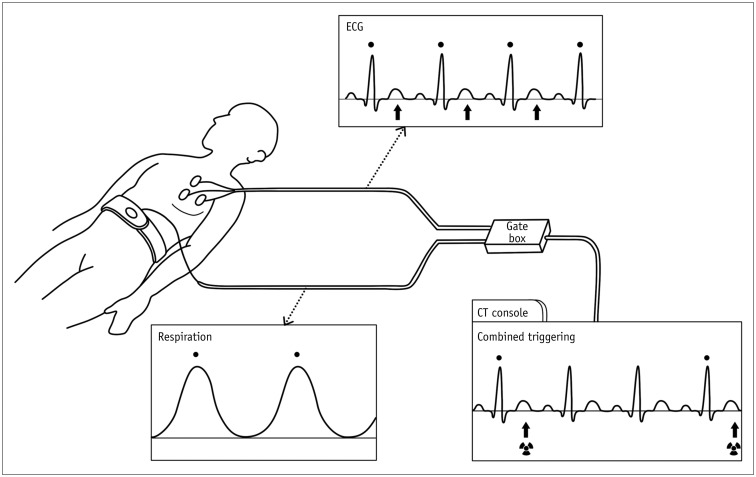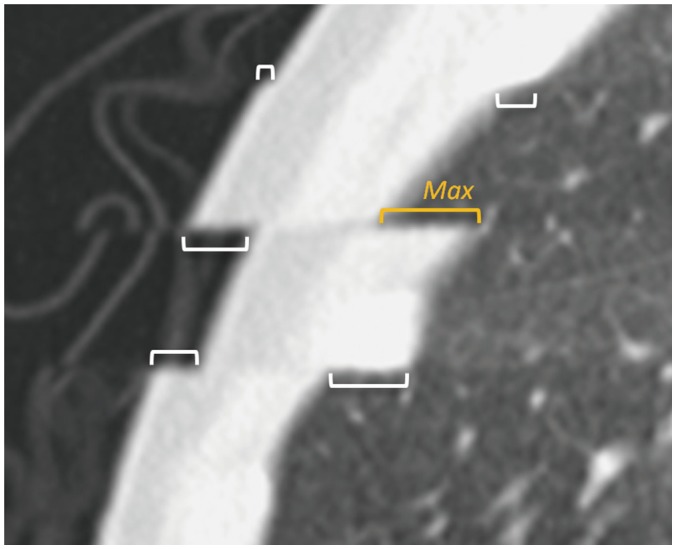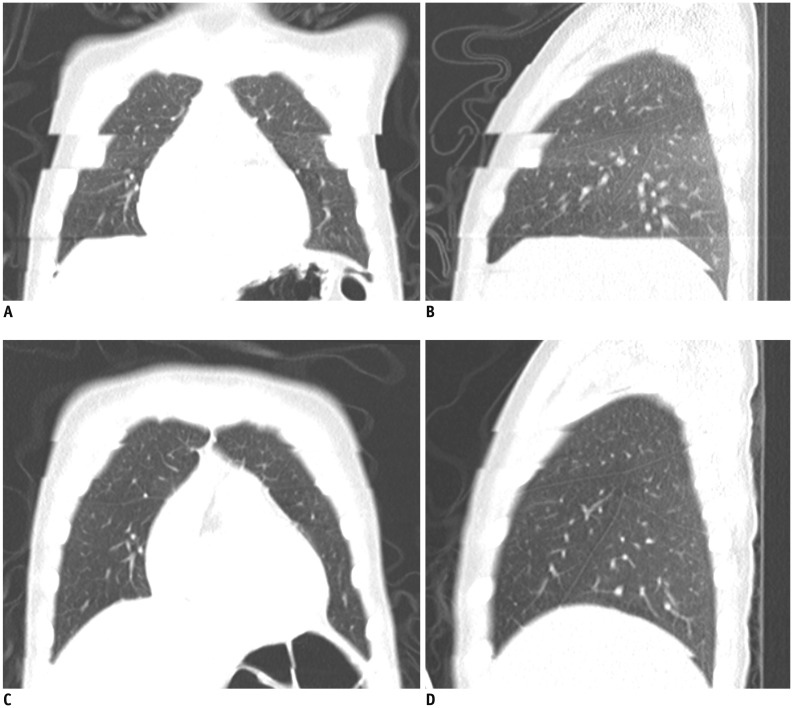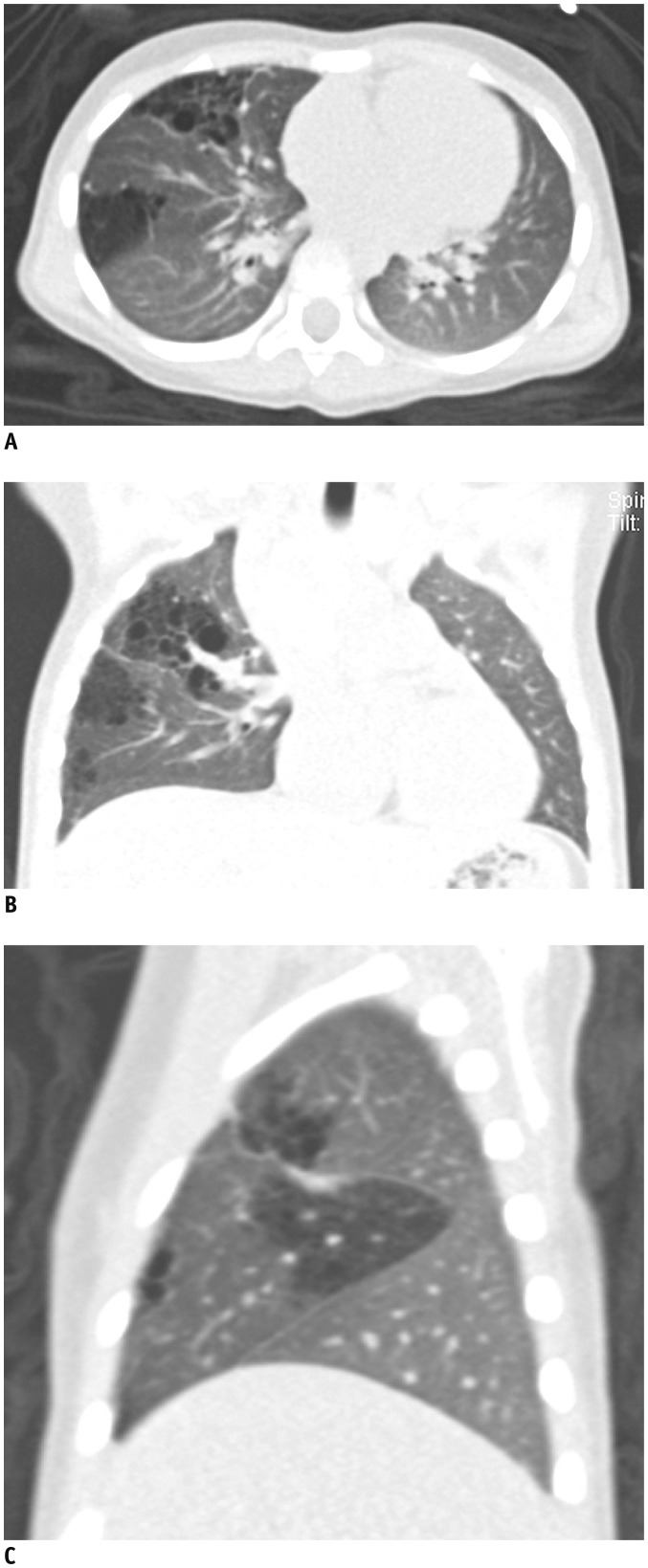1. Montaudon M, Berger P, Blachère H, De Boucaud L, Latrabe V, Laurent F. Thin-section CT of the lung: influence of 0.5-s gantry rotation and ECG triggering on image quality. Eur Radiol. 2001; 11:1681–1687. PMID:
11511889.

2. Ha HI, Goo HW, Seo JB, Song JW, Lee JS. Effects of high-resolution CT of the lung using partial versus full reconstruction on motion artifacts and image noise. AJR Am J Roentgenol. 2006; 187:618–622. PMID:
16928921.

3. Schoepf UJ, Becker CR, Bruening RD, Helmberger T, Staebler A, Leimeister P, et al. Electrocardiographically gated thin-section CT of the lung. Radiology. 1999; 212:649–654. PMID:
10478227.

4. Nishiura M, Johkoh T, Yamamoto S, Honda O, Kozuka T, Koyama M, et al. Electrocardiography-triggered high-resolution CT for reducing cardiac motion artifact: evaluation of the extent of ground-glass attenuation in patients with idiopathic pulmonary fibrosis. Radiat Med. 2007; 25:523–528. PMID:
18085403.

5. Kalender WA, Rienmüller R, Seissler W, Behr J, Welke M, Fichte H. Measurement of pulmonary parenchymal attenuation: use of spirometric gating with quantitative CT. Radiology. 1990; 175:265–268. PMID:
2315492.

6. Mori M, Murata K, Takahashi M, Shimoyama K, Ota T, Morita R, et al. Accurate contiguous sections without breath-holding on chest CT: value of respiratory gating and ultrafast CT. AJR Am J Roentgenol. 1994; 162:1057–1062. PMID:
8165981.

7. Robinson TE, Leung AN, Moss RB, Blankenberg FG, al-Dabbagh H, Northway WH. Standardized high-resolution CT of the lung using a spirometer-triggered electron beam CT scanner. AJR Am J Roentgenol. 1999; 172:1636–1638. PMID:
10350305.

8. Zaporozhan J, Ley S, Unterhinninghofen R, Saito Y, Fabel-Schulte M, Keller S, et al. Free-breathing three-dimensional computed tomography of the lung using prospective respiratory gating: charge-coupled device camera and laser sensor device in an animal experiment. Invest Radiol. 2006; 41:468–475. PMID:
16625110.
9. Long FR, Castile RG, Brody AS, Hogan MJ, Flucke RL, Filbrun DA, et al. Lungs in infants and young children: improved thin-section CT with a noninvasive controlled-ventilation technique--initial experience. Radiology. 1999; 212:588–593. PMID:
10429722.

10. Long FR, Castile RG. Technique and clinical applications of full-inflation and end-exhalation controlled-ventilation chest CT in infants and young children. Pediatr Radiol. 2001; 31:413–422. PMID:
11436888.

11. Mueller KS, Long FR, Flucke RL, Castile RG. Volume-monitored chest CT: a simplified method for obtaining motion-free images near full inspiratory and end expiratory lung volumes. Pediatr Radiol. 2010; 40:1663–1669. PMID:
20508926.

12. Lee EY, Mason KP, Zurakowski D, Waltz DA, Ralph A, Riaz F, et al. MDCT assessment of tracheomalacia in symptomatic infants with mediastinal aortic vascular anomalies: preliminary technical experience. Pediatr Radiol. 2008; 38:82–88. PMID:
18038169.

13. Ritchie CJ, Godwin JD, Crawford CR, Stanford W, Anno H, Kim Y. Minimum scan speeds for suppression of motion artifacts in CT. Radiology. 1992; 185:37–42. PMID:
1523332.

14. Thiyagarajan R, Sinha SN, Ravichandran R, Samuvel K, Yadav G, Sigamani AK, et al. Respiratory gated radiotherapy-pretreatment patient specific quality assurance. J Med Phys. 2016; 41:65–70. PMID:
27051173.

15. Werner MK, Parker JA, Kolodny GM, English JR, Palmer MR. Respiratory gating enhances imaging of pulmonary nodules and measurement of tracer uptake in FDG PET/CT. AJR Am J Roentgenol. 2009; 193:1640–1645. PMID:
19933659.

16. Ley S, Ley-Zaporozhan J, Unterhinninghofen R, Saito Y, Fabel-Schulte M, Weinheimer O, et al. Investigation of retrospective respiratory gating techniques for acquisition of thin-slice 4D-multidetector-computed tomorgraphy (MDCT) of the lung: feasibility study in a large animal model. Exp Lung Res. 2006; 32:395–412. PMID:
17162648.

17. Behzadi C, Groth M, Henes FO, Schwarz D, Deibele A, Begemann PG, et al. Intraindividual comparison of image quality using retrospective and prospective respiratory gating for the acquisition of thin sliced four dimensional multidetector CT of the thorax in a porcine model. Exp Lung Res. 2015; 41:489–498. PMID:
26495957.

18. Oechsner M, Pracht ED, Staeb D, Arnold JF, Köstler H, Hahn D, et al. Lung imaging under free-breathing conditions. Magn Reson Med. 2009; 61:723–727. PMID:
19097250.

19. Teräs M, Kokki T, Durand-Schaefer N, Noponen T, Pietilä M, Kiss J, et al. Dual-gated cardiac PET-clinical feasibility study. Eur J Nucl Med Mol Imaging. 2010; 37:505–516. PMID:
19789872.

20. Goo HW, Yang DH. Coronary artery visibility in free-breathing young children with congenital heart disease on cardiac 64-slice CT: dual-source ECG-triggered sequential scan vs. single-source non-ECG-synchronized spiral scan. Pediatr Radiol. 2010; 40:1670–1680. PMID:
20464385.

21. Goo HW. Current trends in cardiac CT in children. Acta Radiol. 2013; 54:1055–1062. PMID:
23104372.

22. Goo HW. Individualized volume CT dose index determined by cross-sectional area and mean density of the body to achieve uniform image noise of contrast-enhanced pediatric chest CT obtained at variable kV levels and with combined tube current modulation. Pediatr Radiol. 2011; 41:839–847. PMID:
21656275.

23. Goo HW. CT radiation dose optimization and estimation: an update for radiologists. Korean J Radiol. 2012; 13:1–11. PMID:
22247630.

24. Lell MM, Scharf M, Eller A, Wuest W, Allmendinger T, Fuchs F, et al. Feasibility of respiratory-gated high-pitch spiral CT: free-breathing inspiratory image quality. Acad Radiol. 2016; 23:406–412. PMID:
26853970.
25. Bae KT. Peak contrast enhancement in CT and MR angiography: when does it occur and why? Pharmacokinetic study in a porcine model. Radiology. 2003; 227:809–816. PMID:
12702823.

26. Goo HW. State-of-the-art CT imaging techniques for congenital heart disease. Korean J Radiol. 2010; 11:4–18. PMID:
20046490.

27. Goo HW. State-of-the-art pediatric chest imaging. Pediatr Radiol. 2013; 43:261. PMID:
23417251.

28. Goo HW. Advanced functional thoracic imaging in children: from basic concepts to clinical applications. Pediatr Radiol. 2013; 43:262–268. PMID:
23417252.










 PDF
PDF ePub
ePub Citation
Citation Print
Print


 XML Download
XML Download